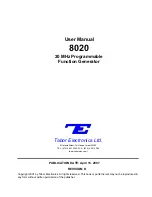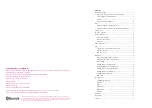
S1 series standard inverter
-182-
The CRC check value is incorrect due to the disorder of the frames, and thus a communication fault
occurs.
The following table describes the standard structure of an RTU frame.
START (frame header)
T1-T2-T3-T4 (transmission time of 3.5 bytes)
ADDR (slave address domain)
Communication address: 0
–247 (decimal system) (0 is the
broadcast address)
CMD (function domain)
03H: read slave parameters
06H: write slave parameters
DATA (N-1)
...
DATA (0)
(data domain)
Data of 2×N bytes, main content of the communication as well
as the core of data exchanging
CRC CHK (LSBs)
Detection value: CRC (16 bits)
CRC CHK high bit (MSBs)
END (frame tail)
T1-T2-T3-T4 (transmission time of 3.5 bytes)
9.3.2.2 RTU communication frame error check modes
During the transmission of data, errors may occur due to various factors. Without check, the data
receiving device cannot identify data errors and may make a wrong response. The wrong response
may cause severe problems. Therefore, the data must be checked.
The check is implemented as follows: The transmitter calculates the to-be-transmitted data based on
a specific algorithm to obtain a result, adds the result to the rear of the message, and transmits them
together. After receiving the message, the receiver calculates the data based on the same algorithm
to obtain a result, and compares the result with that transmitted by the transmitter. If the results are
the same, the message is correct. Otherwise, the message is considered wrong.
The error check of a frame includes two parts, namely, bit check on individual bytes (that is, odd/even
check using the check bit in the character frame), and whole data check (CRC check).
Bit check on individual bytes (odd/even check)
You can select the bit check mode as required, or you can choose not to perform the check, which will
affect the check bit setting of each byte.
Definition of even check: Before the data is transmitted, an even check bit is added to indicate
whether the number of "1" in the to-be-transmitted data is odd or even. If it is even, the check bit is set
to "0"; and if it is odd, the check bit is set to "1".
Definition of odd check: Before the data is transmitted, an odd check bit is added to indicate whether
the number of "1" in the to-be-transmitted data is odd or even. If it is odd, the check bit is set to "0";
and if it is even, the check bit is set to "1".
For example, the data bits to be transmitted are "11001110", including five "1". If the even check is
applied, the even check bit is set to "1"; and if the odd check is applied, the odd check bit is set to "0".
During the transmission of the data, the odd/even check bit is calculated and placed in the check bit of
the frame. The receiving device performs the odd/even check after receiving the data. If it finds that
















































